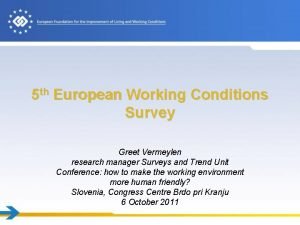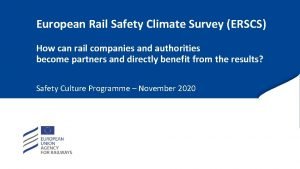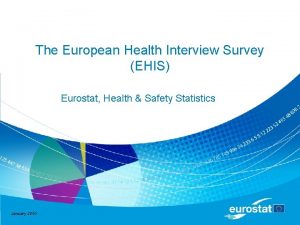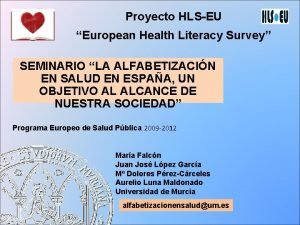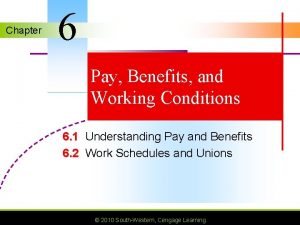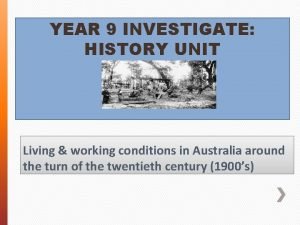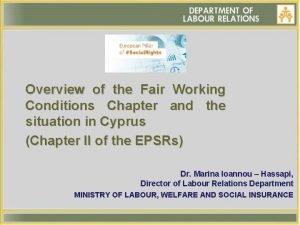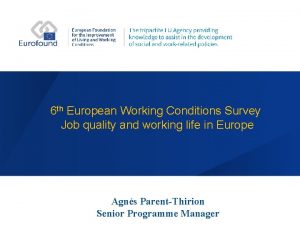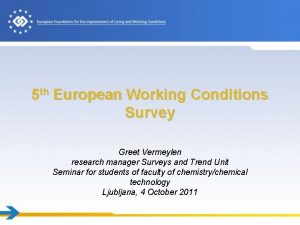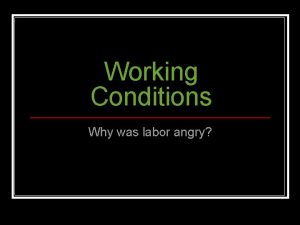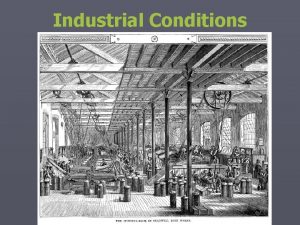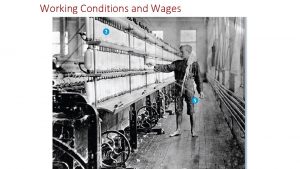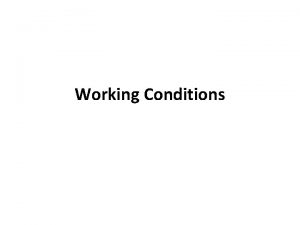Measuring working conditions in European Working Conditions Survey











- Slides: 11

Measuring working conditions in European Working Conditions Survey Greet Vermeylen European Foundation for the Improvement of Living and Working Conditions Measurement of quality of employment meeting, 14 october 2009 05/11/2020 1

European Foundation for the Improvement of Living and Working Conditions l l l 05/11/2020 Agency of the EU, based in Dublin Tripartite Board (delegations from all MS + European Commission) Mandate: to do European-wide comparative policyrelevant research 4 surveys: EWCS, EQLS, ECS 4 Network of correspondents: EIRO, EWCO, ERM 4 Qualitative research, case studies, best practices, … 2

Monitoring working conditions through a multidimensional concept: quality of work and employment Career and employment security. Employment status. Income. Social protection. Workers’ rights Health and well-being. Health problems. Risk exposure. Work organisation Quality of work and employment Skills development. Qualifications. Training. Learning organisation. Career development Reconciliation of working and non-working life. Working/non-working time. Social infrastructures 05/11/2020 3

Why doing a survey? : l 05/11/2020 Objectives of the European Working Conditions Survey: to provide an overview of working conditions in order to: 4 (1) Assess and quantify working conditions of both employees and self-employed across Europe on a harmonised basis; 4 (2) Analyse relationships between changes/ working conditions; 4 (3) Identify groups at risk and issues of concern/progress; 4 (4) Monitor trends and 4 (5) Contribute to the Lisbon Strategy on quality of work and employment by providing homogeneous indicators on this issue to a European audience. 4

European Working Conditions Survey: some characteristics l l l 05/11/2020 Working conditions : results of the interaction between a job and an individual in an environment Broad thematic coverage: working time, physical / psychosocial risks, work organisation, work satisfaction, work-related health outcomes / absenteeism, non-work activities (domestic care, education etc)…. Currently preparing 5 th wave : 1991 / 1995 /2000 (2001/2 in NMS) and 2005. Fieldwork of 5 th EWCS foreseen in Spring Very comparative survey : exactly the same questionnaire and methodological standards, managed and coordinated centrally, with a network of contractors carrying out the fieldwork. Extensive package of quality control and quality assurance measures throughout the process 5

Aim of the survey: try and give a picture of working conditions of workers in the EU 4 Through a harmonised survey l l 4 a survey, based on one questionnaire, translated in all the languages (25 languages + 16 variants) Same methodology, same quality standards applied everywhere Working conditions of all workers l l People in employment: self-employed and employees (LFS definition) Some special questions to either group of workers (filters) Face to face interview in people’s homes (40 min on average) More than 30 countries l l Around 30000 interviews in total l l 4 EU 27, some IPA countries, some neighbour countries eg Norway 1000 per country except 600 for smaller countries In 5 th EWCS: top up by countries is possible Ambitions and limitations of survey Sample size limited : l l Aim: not to have produce statistics: other instruments do this better, eg LFS on employmment issues Rather: look at correlations, impacts, effects l l l 05/11/2020 Working conditions do not change that quickly l a survey cycle of 4/5 years is sufficient 6

How do we do it? l Questionnaire 4 Has expanded over time (from 30 to 100 questions), trying to capture ‘world of work’ l 4 Keep ‘trends’ if possible: measure change over time l l Work intensity, working time etc Harmonized survey but different levels of objectivation / understanding of working conditions and national contexts 4 05/11/2020 Some questions which have been changed: e. g. more on place of work, gender mainstreaming, blurring frontiers, precariousness, … to be taken into account in analysis 7

The European Working Conditions Surveys l l l 05/11/2020 4 so far, 5 th ewcs fieldwork to start in January 2010 From 1991 to 2005: questionnaire has expanded from 30 to 100 questions – however attempt to keep ‘trends’ Geographical scope: from 12 countries to probably 34 in 2010 Face to face interviews in people’s homes, 15+ in employment according to LFS standards 5 th ewcs : 4 1 questionnaire. Numerous language versions and variants 4 Probably 34 countries covered : EU 27 + ACC 3+ IPA 3 + NO 4 1000 interviews in each country except 600 for CY, EE, Lxbg, MT and SV but possibilities for MS to top up sample sizes 8

New issues in the 2010 wave l l 05/11/2020 Precarious work More on work-life balance, blurring fronteers Changes in the workplace Stress, mental health 9

Different steps l l l 05/11/2020 Fieldwork: Spring 2010 Analysis: Autumn 2010/2011 Secondary analyses Other research methods, case studies etc Dataset available through Essex data archive: contact Camilla Galli da Bino at gdb@eurofound. europa. eu 10

Thank you More info: www. eurofound. europa. eu Or gve@eurofound. europa. eu 05/11/2020 11
 European working conditions survey 2020
European working conditions survey 2020 European working conditions survey
European working conditions survey European rail safety climate survey
European rail safety climate survey European health interview survey (ehis)
European health interview survey (ehis) European health literacy survey
European health literacy survey 叫叫abcd
叫叫abcd Kondisi kerja adalah
Kondisi kerja adalah Chapter 6 pay benefits and working conditions
Chapter 6 pay benefits and working conditions Working conditions during the industrial revolution
Working conditions during the industrial revolution Living and working conditions in australia 1900
Living and working conditions in australia 1900 Job description computer programmer
Job description computer programmer Fair working conditions
Fair working conditions

